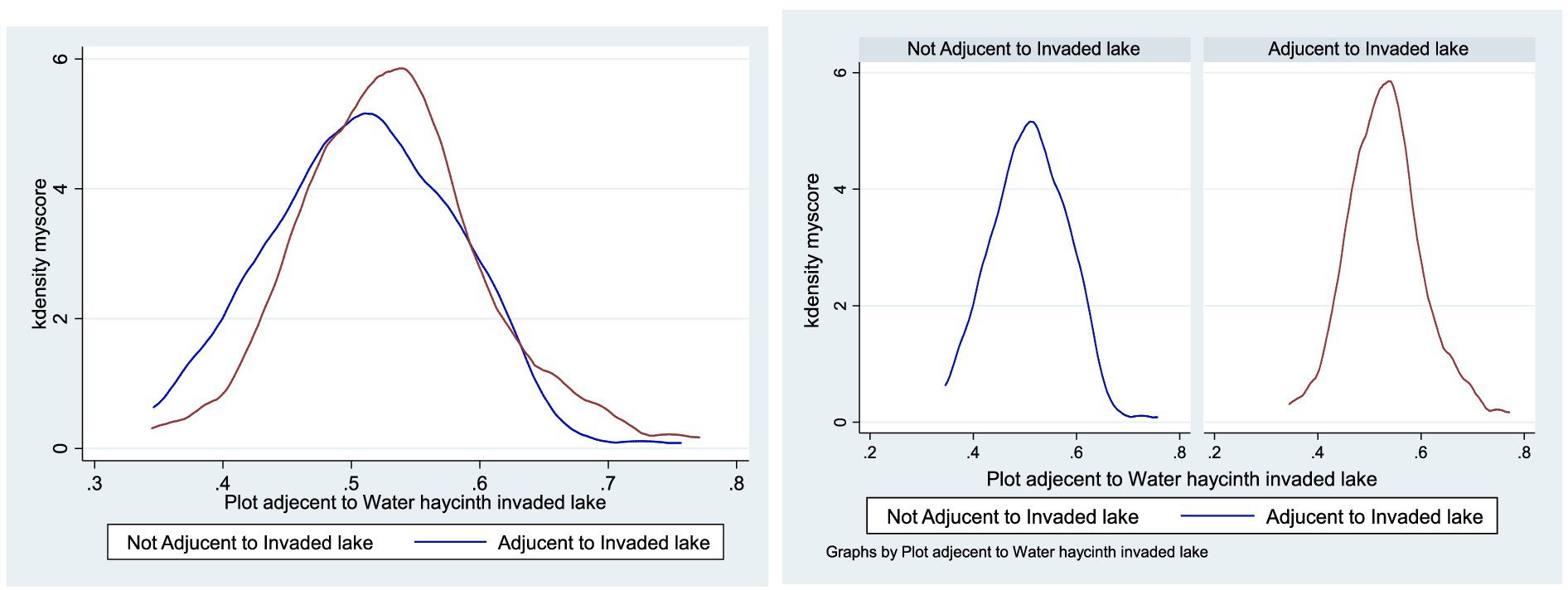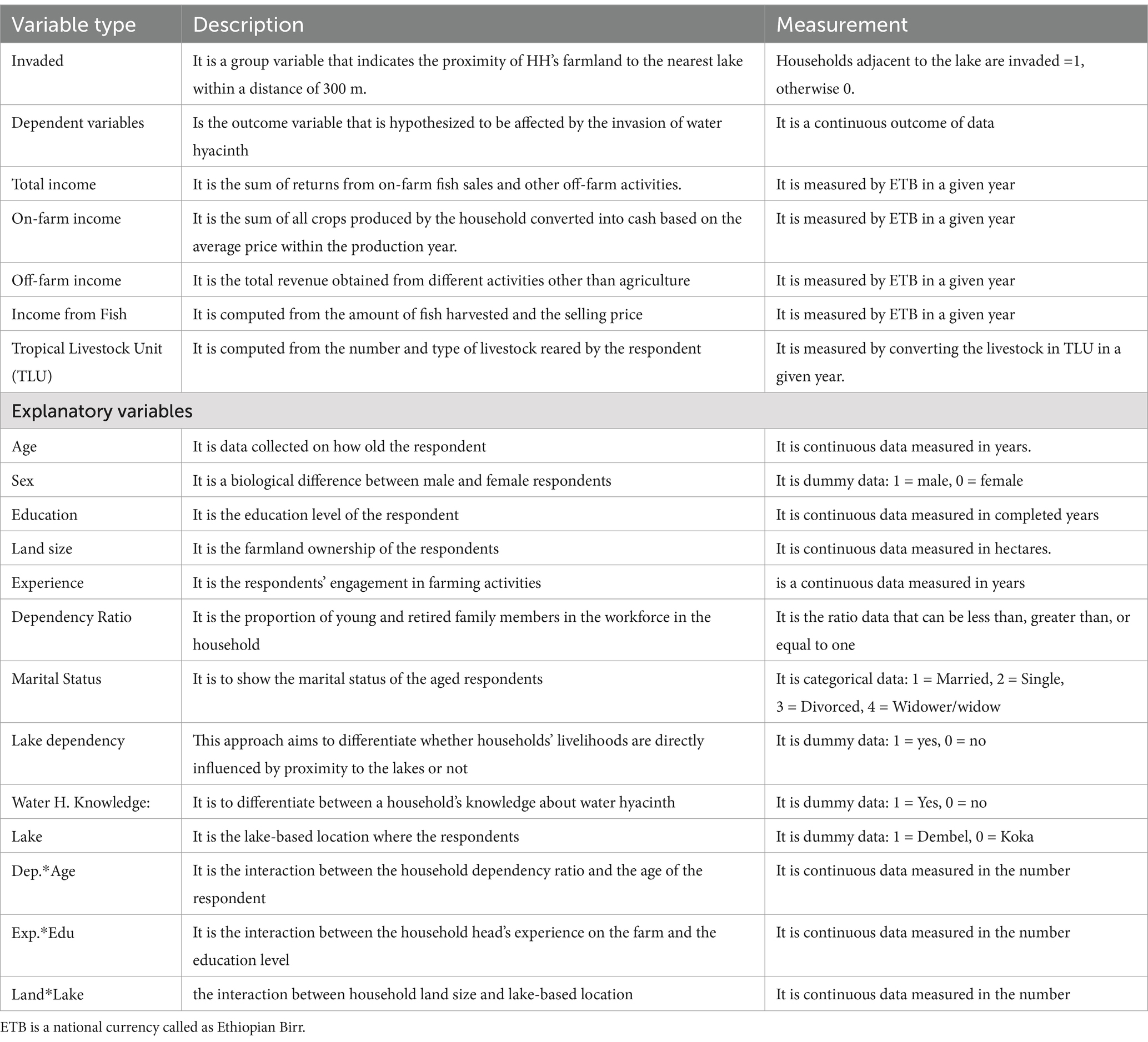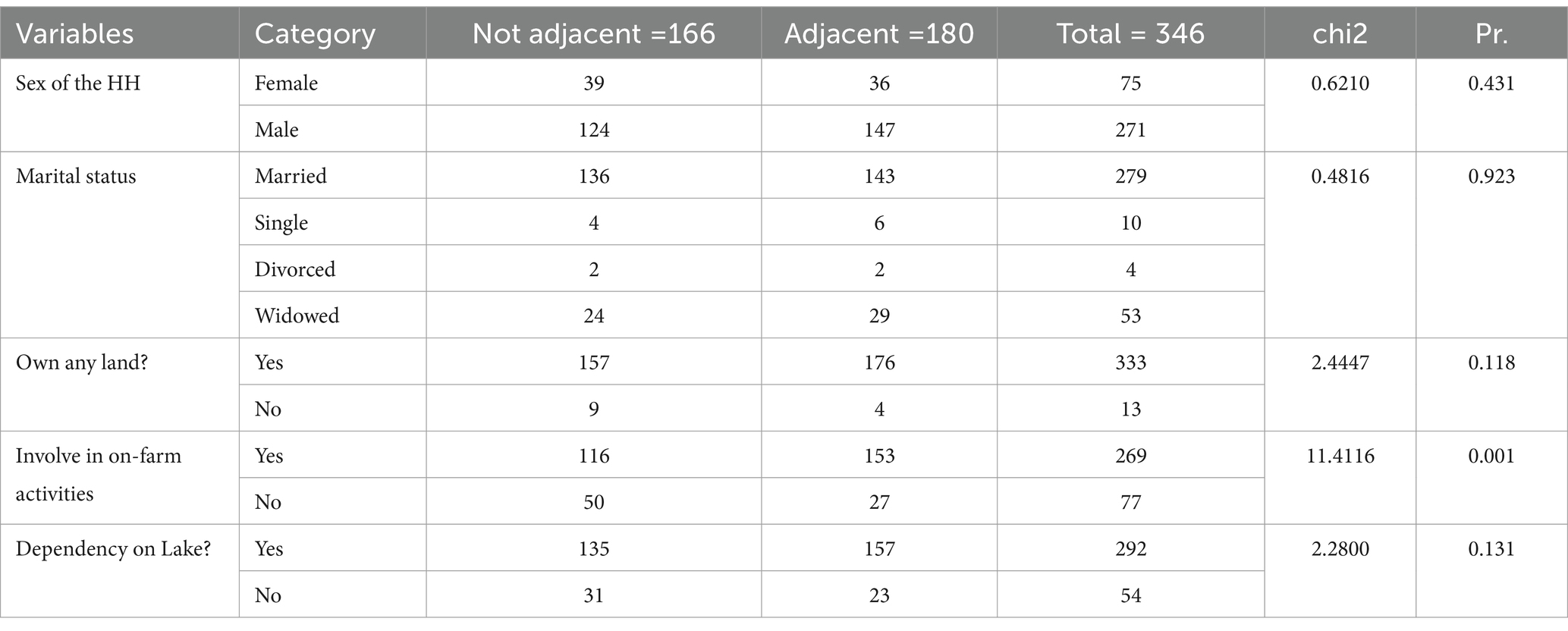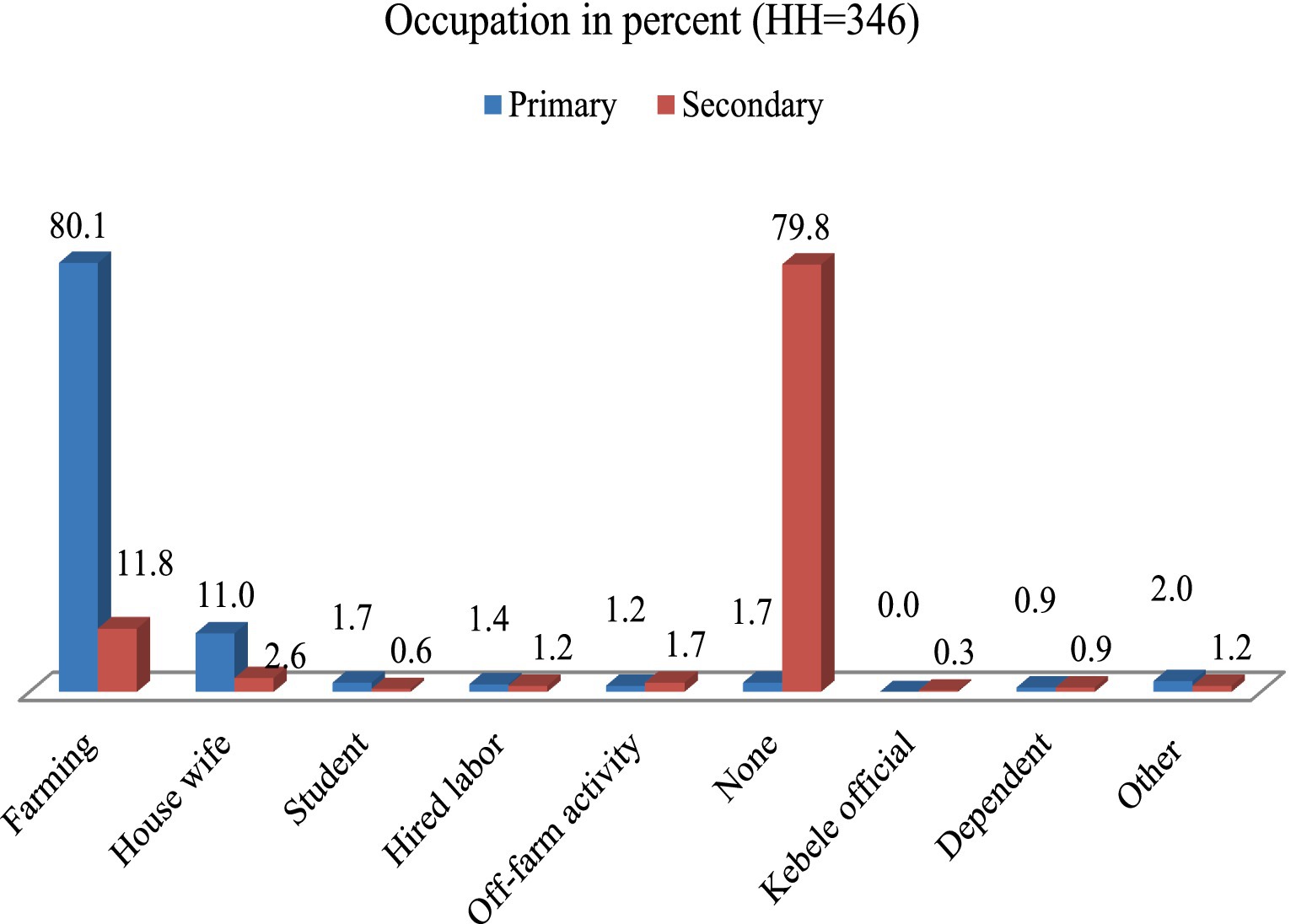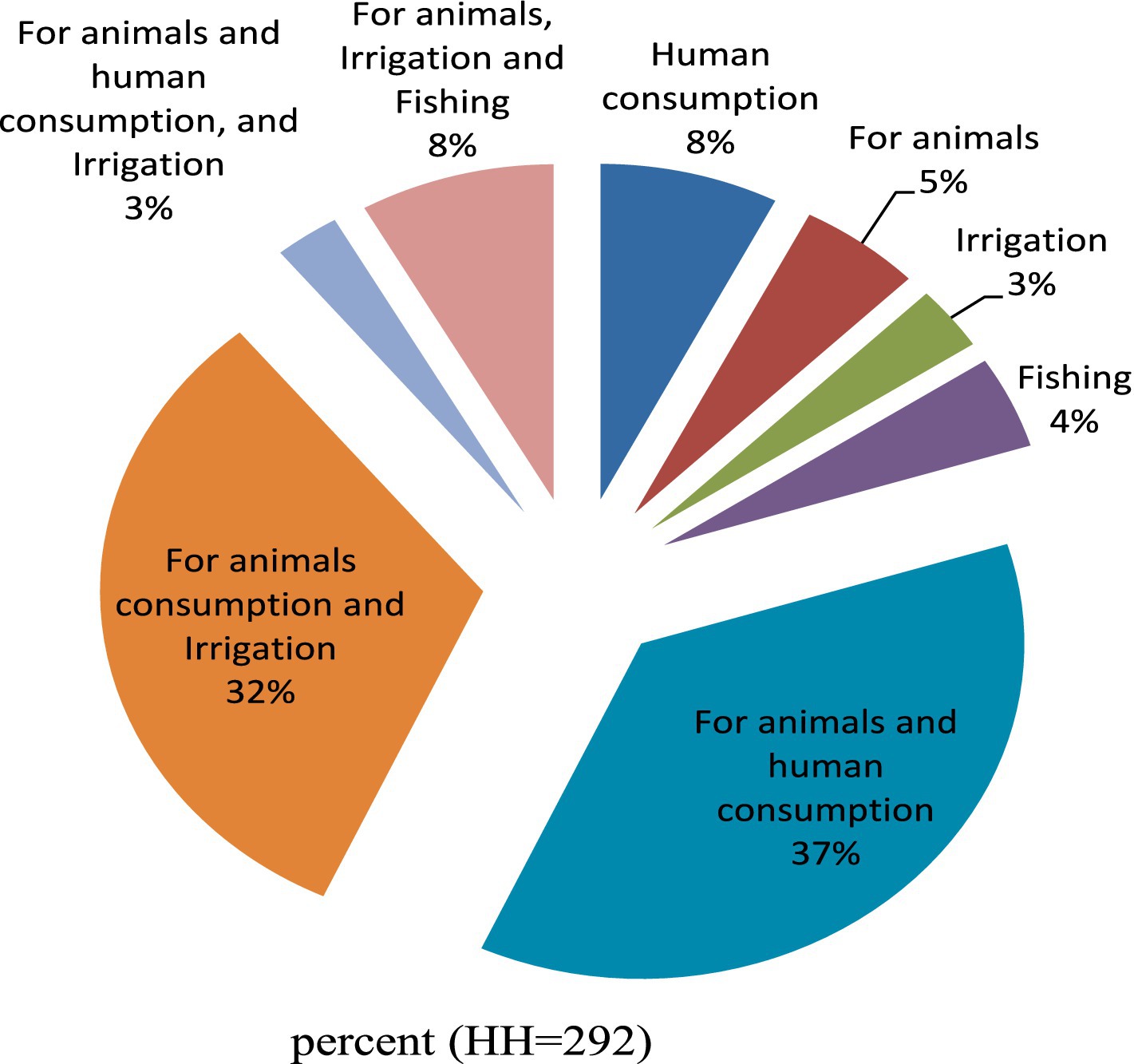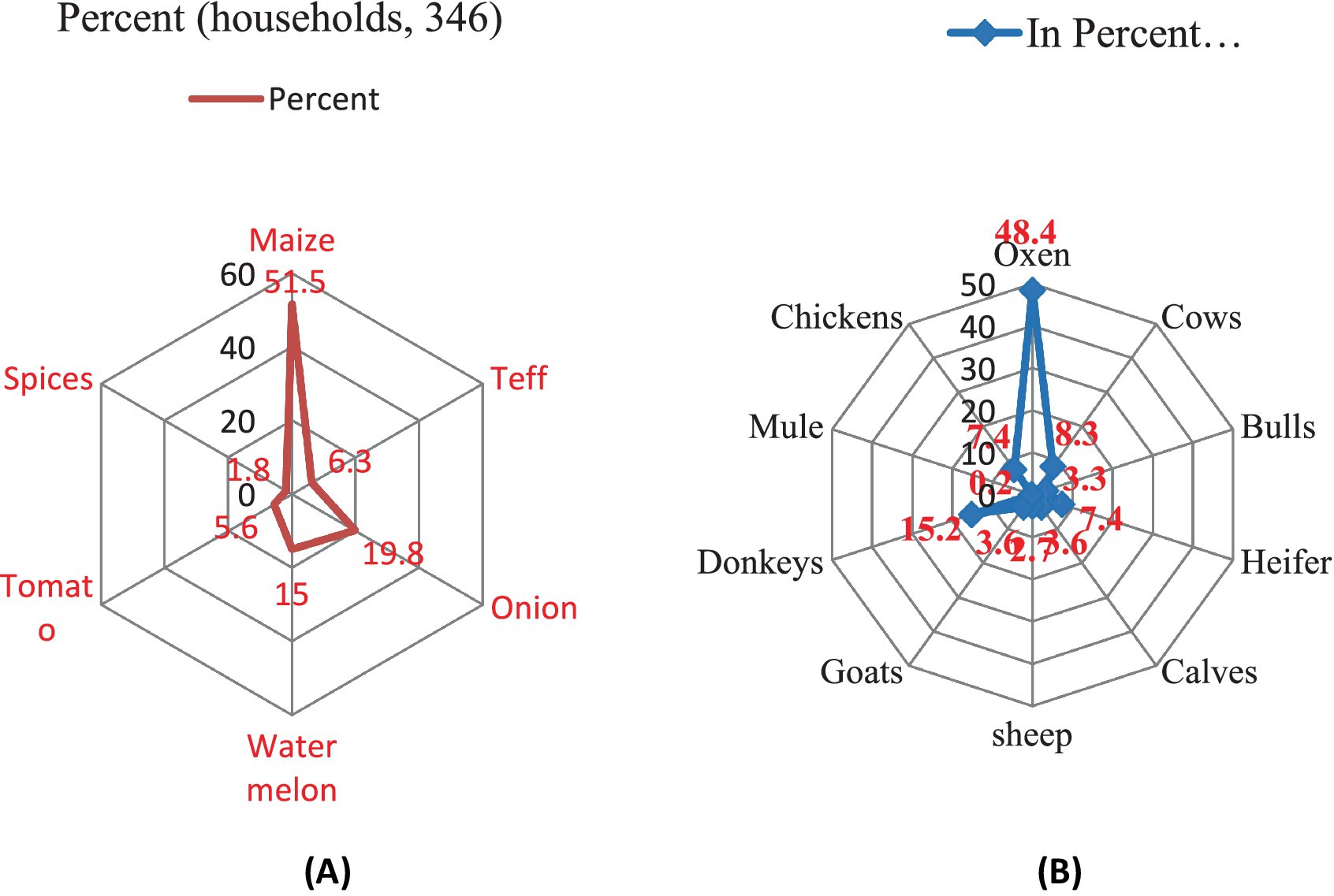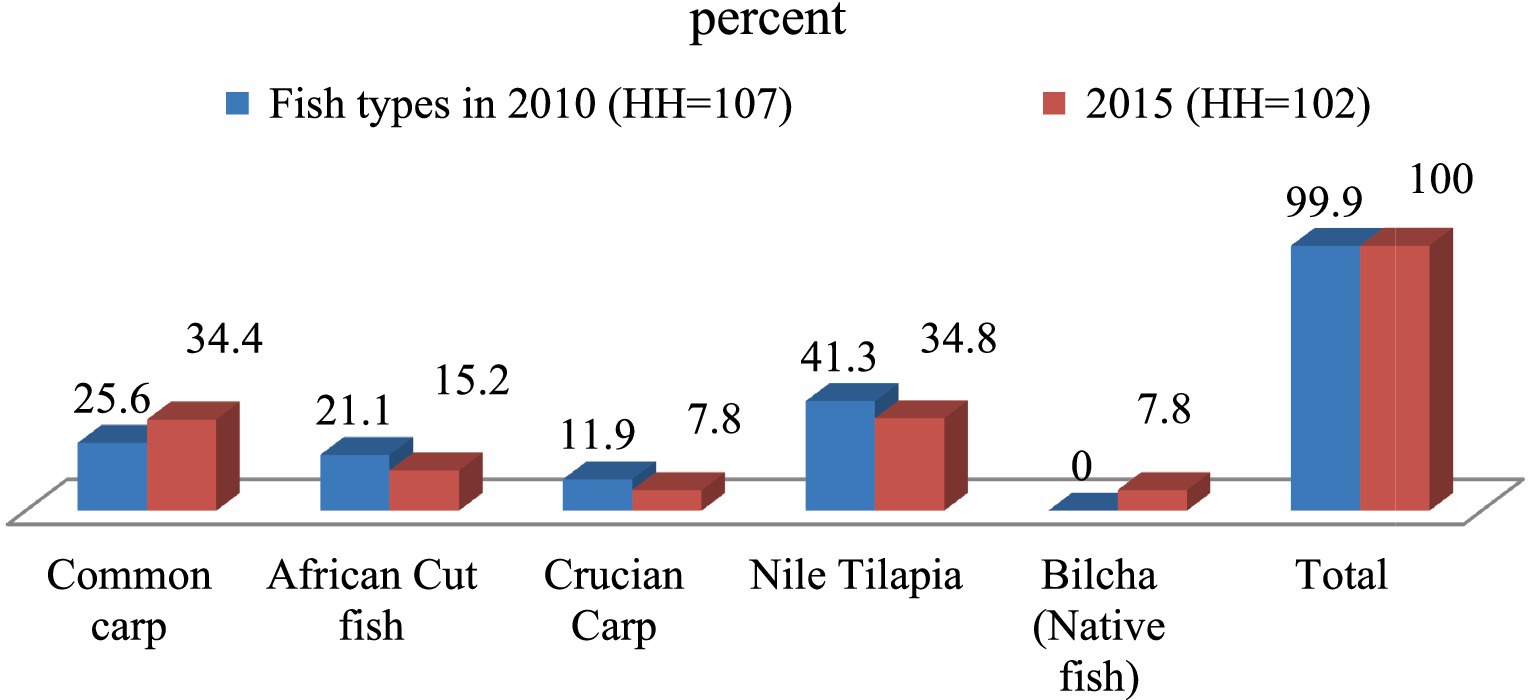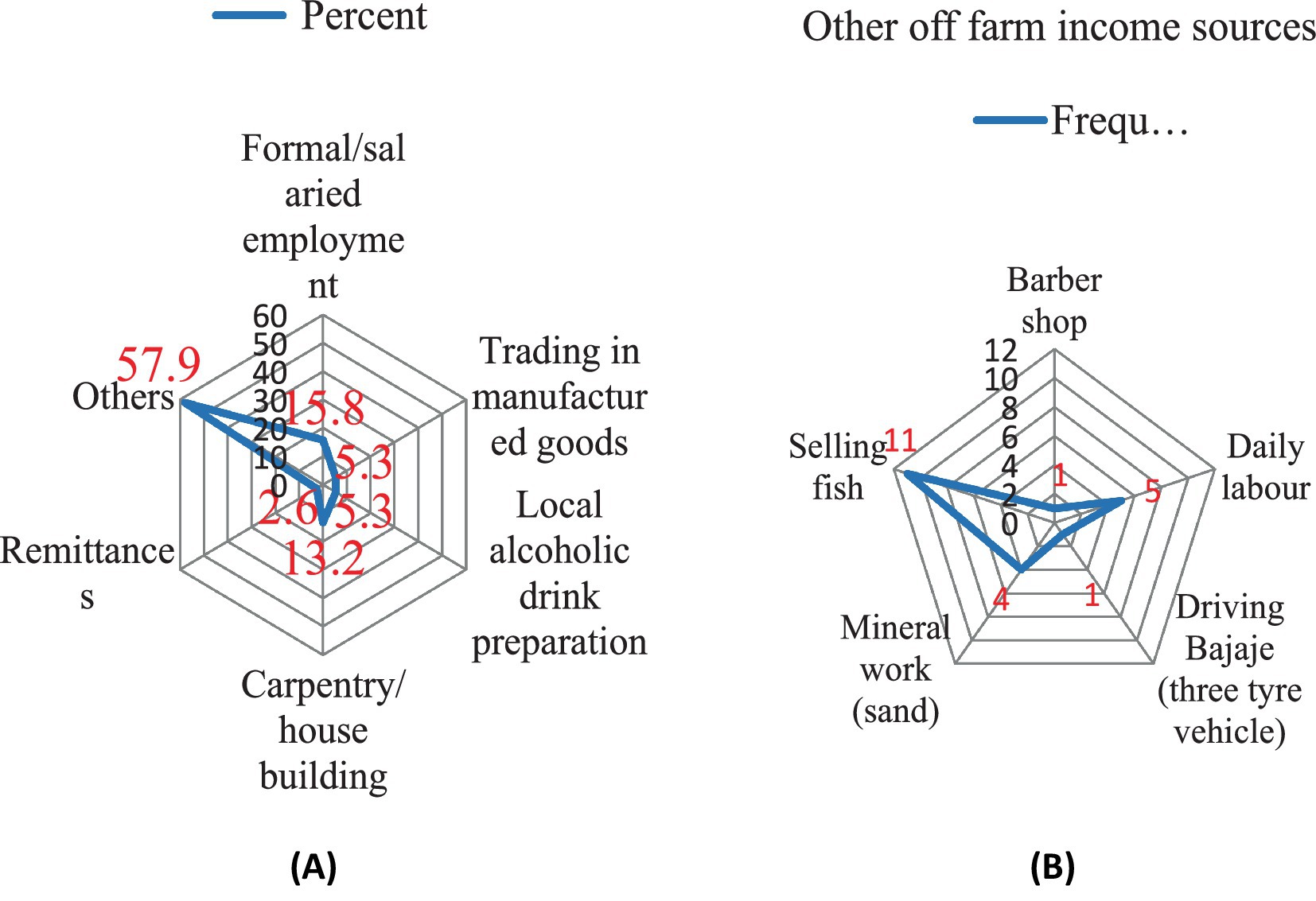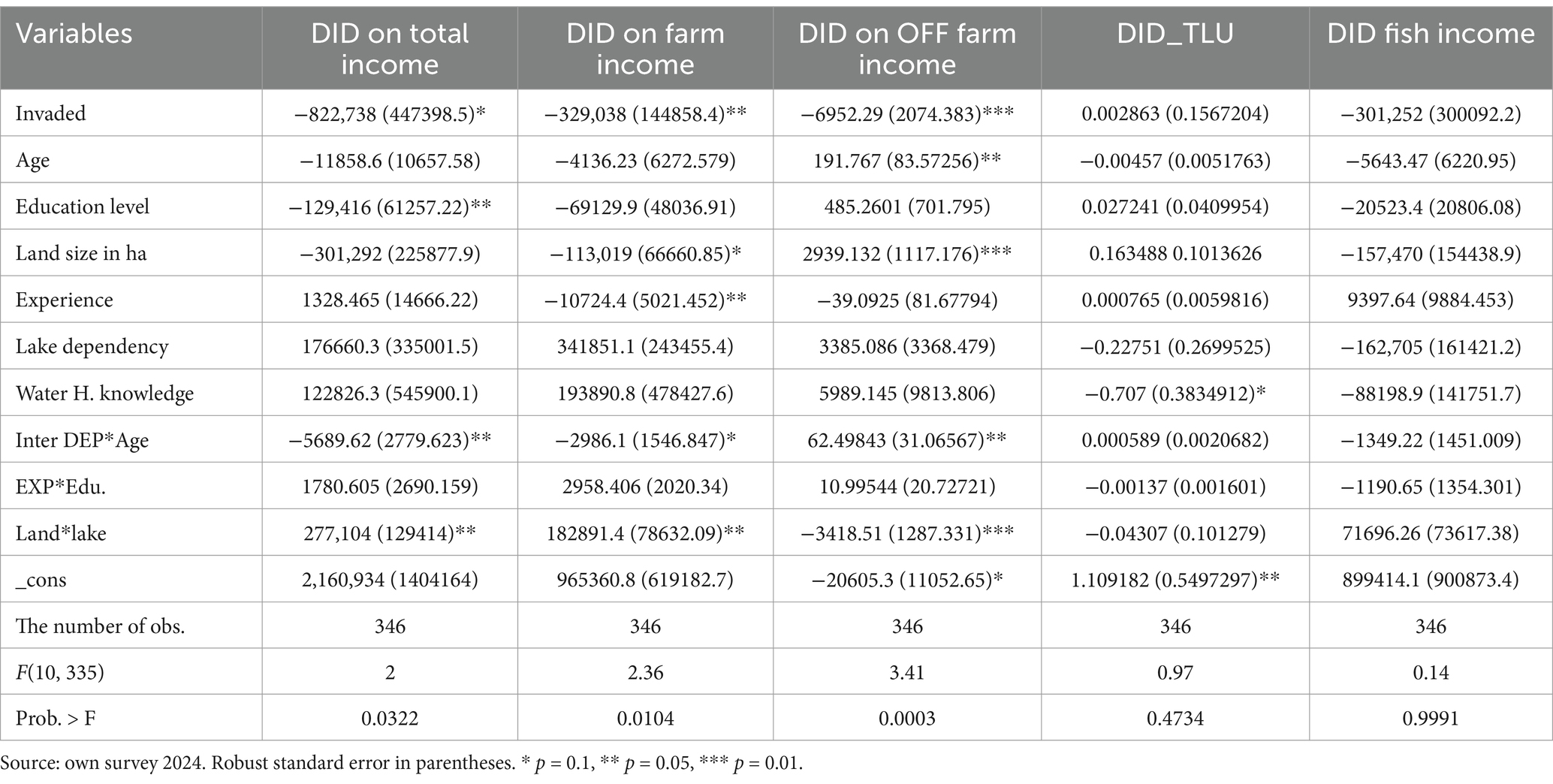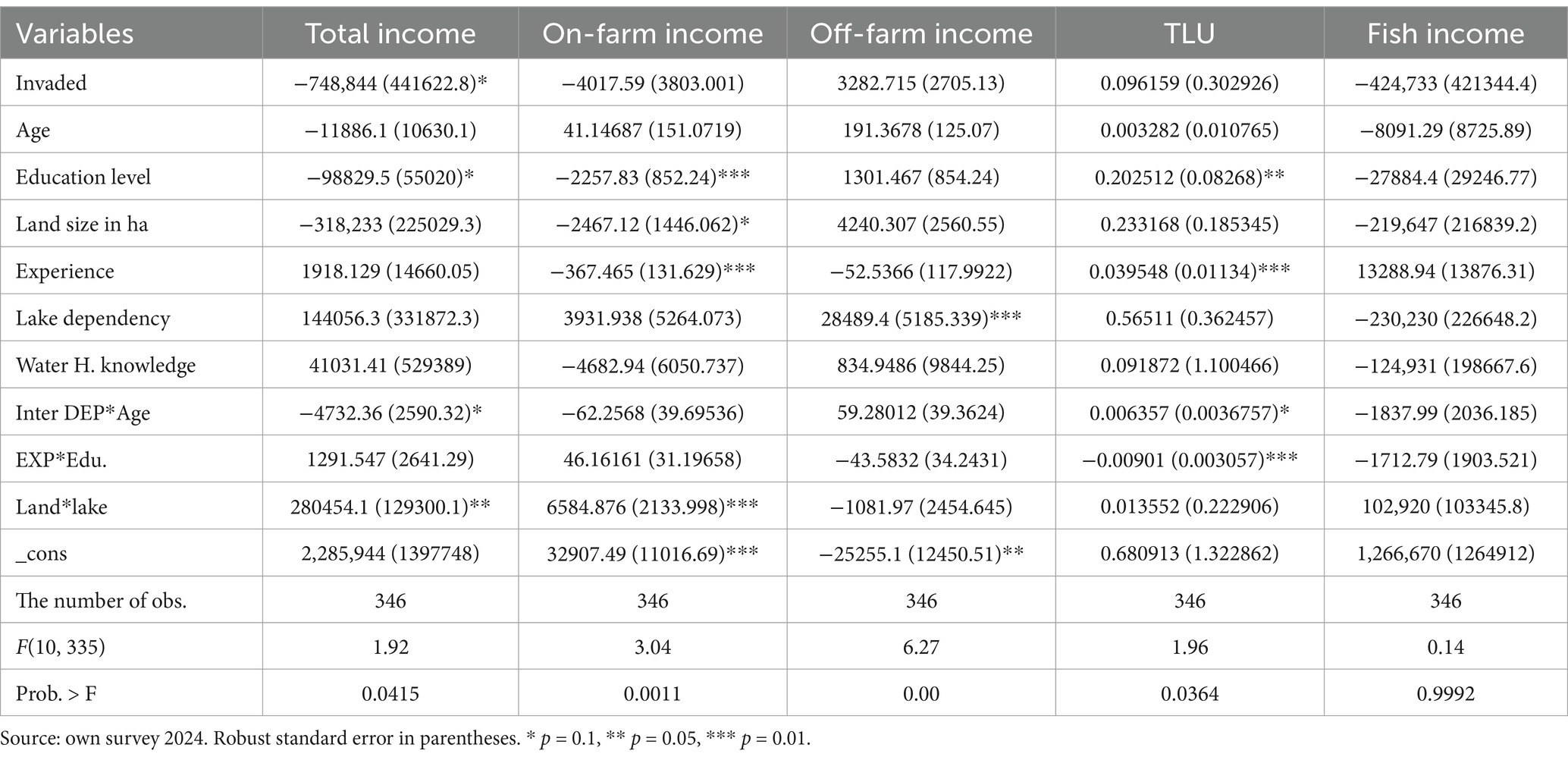- 1Center for Environment and Development, College of Development Studies, Addis Ababa University, Addis Ababa, Ethiopia
- 2College of Agriculture and Natural Resource, Salale University, Fitche, Ethiopia
- 3Department of Biological Sciences, Faculty of Sciences, Botswana University of Agriculture and Natural Resources, Gaborone, Botswana
- 4Urban Development and Transformation Training Cluster, Training Institute, Ethiopian Civil Service University, Addis Ababa, Ethiopia
Water hyacinth spans extensive geographic areas in tropical and semi-tropical regions. Its impact on livelihoods is connected to the production of crops, fish, livestock, and other activities that influence costs and returns for rural smallholders. This invasive weed affects crop production by invading farmland adjacent to the lakes and has an impact on livestock by covering grazing land meant for animal feed. Although several studies have been conducted in Ethiopia, the livelihood impact of water hyacinth has been scarcely analyzed, quantified, and documented. This study evaluates the adverse effects of water hyacinth, particularly on crop production, livestock management, fish harvesting, and other off-farm incomes, by comparing groups of respondents’ proximity to Lake Koka and Demel in the Central Rift Valley of Ethiopia before and after a specified period. Data were collected from 348 sample households based on the nearness of farmlands to the lakes, both adjacent to (≤ 300 m) and distant from invaded lakes, six focus group discussions, six key informant interviews, and field observations to assess the impact using propensity scores, difference-in-differences, and weighted least squares methods. The result of difference-in-differences shows a decline in the total annual income by 823 ETB, income from crop production by 329 ETB per year, and income from off-farm activities by 6,952 ETB per year for those living adjacent to the invaded lakes. Although the impact varies according to the intensity of the water hyacinth infestation, it adversely affects rural livelihoods by reducing crop yields and returns from off-farm activities. The study did not find any significant impact on livestock production and harvested fish. Other control variables, such as education, experience, and interactions like dependency-age, experience-education, and land-lake, also influenced the impact of livelihood. As hypothesized, water hyacinth has caused differences in on-farm and off-farm incomes between groups of respondents. Further research is suggested to investigate the fish species favored and affected by this invasive weed. Ultimately, the impact of water hyacinth is of significant interest to affected communities, regional offices, policymakers, and scientists.
1 Introduction
Water hyacinth is one of the invasive aquatic and wetland species that cover extensive geographic areas in tropical and semi-tropical regions (Kriticos and Brunel, 2016; Pan et al., 2015). It inhabits both water bodies and terrestrial environments (Simberloff, 2013). Water hyacinth presents both opportunities and challenges to socioeconomic activities and the environment. It can be utilized as an input in agricultural activities, as well as in the manufacturing and industrial sectors, to produce paper, furniture, biogas, and ethanol (Sharma and Aggarwal, 2020), and various household products (Maulidyna et al., 2021).
The impact of water hyacinth is closely linked to rural livelihoods, including crop, fish, and livestock production, as well as input supply and the cost of management and maintenance. In terms of crop production, it impedes rice seed germination (Mathur and Mathur, 2018), reduces crop yield (Enyew et al., 2020), and consequently lowers returns (Maulidyna et al., 2021). Similarly, weeds affect the food supply by reducing fish populations (Harun et al., 2021) and fish supply (Kateregga and Sterner, 2009). Moreover, water hyacinth negatively impacts the livelihoods of farmers and traders involved in fish marketing (Segbefia et al., 2019) by disrupting business operations (Ezama, 2019). This invasive weed also restricts access to fishing areas, which increases production costs and creates supply shortages (Villamagna and Murphy, 2010). The time required to catch fish has increased due to obstructed boat passages (Harun et al., 2021), limiting fishing grounds (Villamagna and Murphy, 2010). In this context, the maintenance costs of blocked ditches and canals have become high (Dersseh et al., 2019b).
The impact of water hyacinth in Ethiopia has been reported in relation to crop production (Damtie et al., 2022; Enyew et al., 2020), where it competes for water resources (Getahun and Kefale, 2023) and disrupts production activities (Enyew et al., 2020). It challenges plowing activities (Getahun and Kefale, 2023; Tewabe et al., 2017), increasing costs and time expenditure (Getahun and Kefale, 2023). Similarly, water hyacinth affects livestock and feed production (Getahun and Kefale, 2023; Tewabe et al., 2017); it invades grazing lands (Tewabe et al., 2017) and creates a shortage in feed supply (Enyew et al., 2020). The use of water hyacinth as feed can also lead to livestock fatalities related to its content (Damtie et al., 2022).
Water hyacinth also disrupts fishing activities and reduces the harvesting rate (Damtie et al., 2022; Dersseh et al., 2019a; Delele et al., 2021), leading to a decrease in the quantity of fish caught (Enyew et al., 2020; Tewabe et al., 2017). Furthermore, it incurs high costs for weed management (Damtie et al., 2022; Getahun and Kefale, 2023) and the maintenance of ditches and canals (Dersseh et al., 2019b).
Several studies and literature reviews have examined water hyacinths in Ethiopia, focusing on Lake Dembel, Lake Koka, and Aba Samuel Dam. The majority of studies on Lake Tana predominantly address the effects of water hyacinth; Tewabe et al. (2017), perceptions of its impact (Enyew et al., 2020), its infestation potential (Dersseh et al., 2019a), its ecological, economic, and social implications (Getahun and Kefale, 2023), and its effects on rural livelihoods (Damtie et al., 2022).
In contrast, studies on Lakes Dembel and Koka and the Aba Samuel Dam are limited, focusing primarily on socioeconomic and environmental sustainability (Churko et al., 2023a,b), water quality (Getnet et al., 2021), and impact on aquatic life and human activities (Ingwani et al., 2010). However, these studies have scarcely analyzed, quantified, and documented the livelihood impacts of water hyacinths in Lake Dembel, Lake Koka, and Ethiopia more broadly.
Therefore, this study aims to assess the livelihood effects of water hyacinths. Specifically, it addresses the impact of water hyacinth on crop production, livestock management, and fish harvesting by comparing affected and non-affected households before and after a specific period. It is hypothesized that the weed would cause differences in income and tropical livestock unit (TLU) between households adjacent to and away from the lakes. The output of this research will contribute to the formulation of invasive weed management policies in the Rift Valley and Ethiopia as a whole. Additionally, the recommendations will help bridge knowledge gaps in understanding the livelihood impact of water hyacinths.
2 Study area and data
2.1 Study area
The study area is located in the Rift Valley Lakes of Ethiopia and encompasses two lakes, namely Koka and Dembele, which are the largest freshwater lakes in the central part of the country (Figure 1). Lake Koka is located between 8°29’00” N latitude and 39°10’00” E longitude, at 1590 m.a.s.l. elevation. The estimated total area of the lake is 255km2, with a length of 20 km and a width of 15 km. The lake has a shoreline length of 19.5–20.5 km and has a maximum and minimum depth of 14 m and 9 m, respectively. Mojo and Awash rivers are the two major rivers draining to the lake. One big town, Modjo, is located within the Koka Catchment. Though Koka Lake was originally developed for hydropower generation, it is currently used for fish production, irrigation, and flood control in downstream areas. The predominant land use/cover in Koka Catchments is agriculture (both irrigated and rain-fed) and rural settlements.
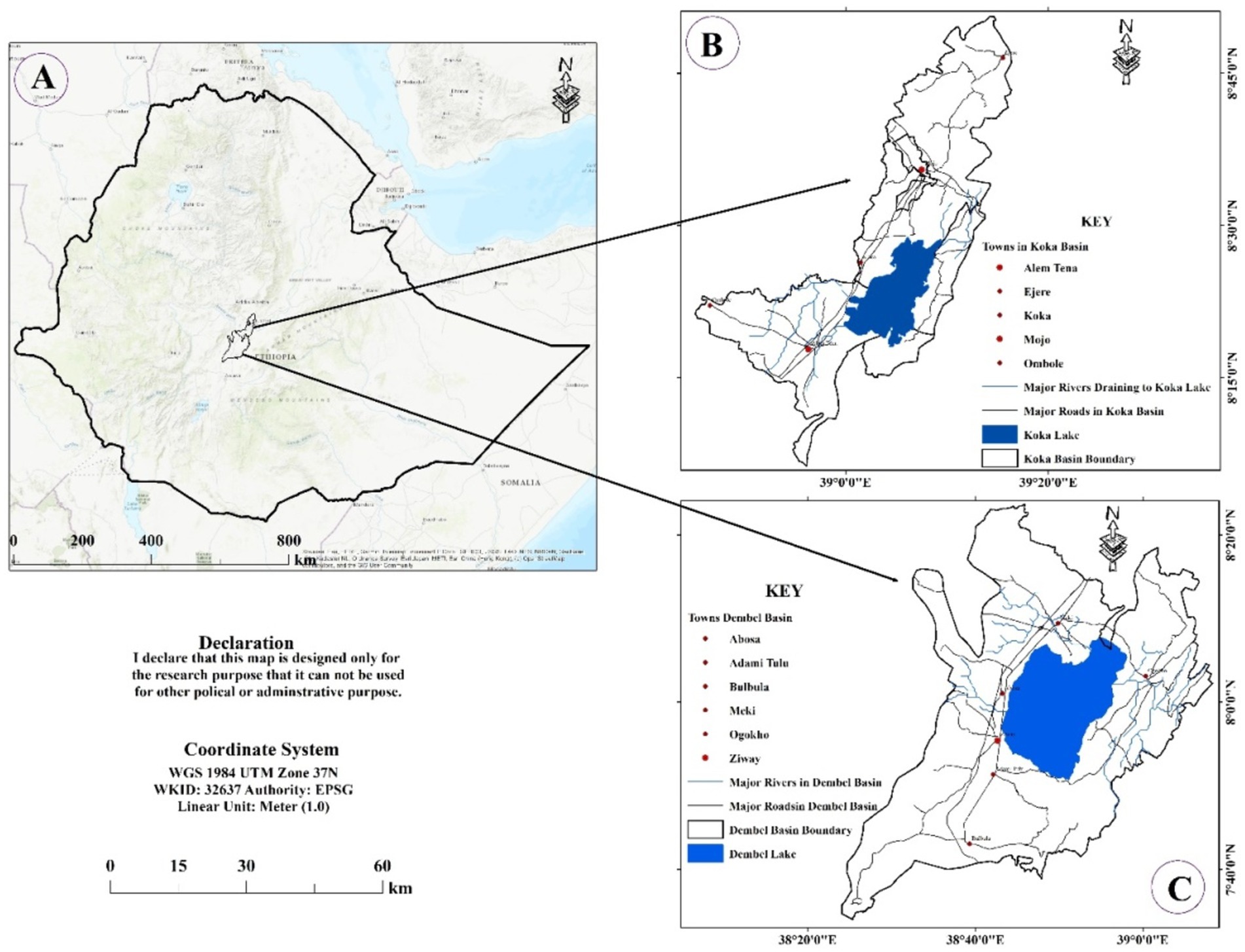
Figure 1. Location map of the study area: (A) Location of Ethiopia in East Africa, (B) Koka Water-shade boundary and other natural and man-made features, and (C) Dembel water-shade boundary and other major natural and man-made features.
Lake Dembel lies between 8°00’00” N latitude and 38°50’00” E longitude, at 1636 m.a.s.l., and has an estimated surface area of 485 km2, with a width of 20 km and a length of 31 km. The lake has a maximum depth of 8.95 m and a mean depth of 2.5 m and is considered the shallowest lake in the Rift Valley. The lake’s surface area fluctuates between 435 and 485 km2 depending on the water inflow. The two major rivers that flow into Lake Dembel are the Ketar and Meki Rivers. Lake Dembel is a freshwater lake that supports different uses, including water supply, irrigation, fishing, and recreation. The lake is being degraded primarily because of various water and land-use activities in its catchment. There is ongoing agricultural transformation. Both small-scale farmers and large horticultural companies use huge amounts of pesticides and fertilizers that have led to nutrient loading, a conducive environment for the proliferation of macrophytes like water hyacinth, which is currently invading the lake at an alarming rate. The expansion of water hyacinth has been threatening the existence of the water body and surrounding iodiversity.
Water flows through the riverbanks, and runoff contributes to water hyacinth seed transport into the lakes (Churko et al., 2024). Similar studies indicated that the feet of animals and beaks of birds contribute to the spread of water hyacinths because they feed in sites of water hyacinth infestation and carry the seed over considerable distances by their bodies. Common aquatic macrophytes around and in Lake Dembel include Cyperus alopecuroides Rottb. (aquatic sedge), Phragmites karka (Retz.) Trin., and Paspalidium geminatum (Forssk.).
2.2 Sampling procedure and sample size
This study was implemented in three districts, Lume, Dugda, and Adami Tulu Jido Kombolcha, in the East Shewa Zones of the Oromia Regional State in Ethiopia. Zones and districts were purposively selected due to the threats of water hyacinths on Dembel and Koka lakes, which are found in these locations. The lakes are among the foremost water bodies, providing several socioeconomic benefits to the local people and the surrounding areas, including the capital city (Addis Ababa). Kebeles1 were randomly selected based on their common boundaries with lakes and the level of water hyacinth invasion. In this case, a list of Kebeles with high water hyacinths (where the whole shoreline of the lakes is covered by the weed) and no water hyacinth infestation was identified through discussion with experts working on water hyacinth management in the Lume, Dugda, and Adami Tulu Jido Kombolcha districts. In addition, the sites were verified by field visits to the study area. Six Kebeles were selected from Lume, six from Dugda, and four from Adami Tulu Jido Kombolcha. Based on the proximity of individual households within the kebele, the respondents were grouped as adjacent (who conducted agricultural activities up to 300 meters from the lakes) and not adjacent to water hyacinth-invaded lakes (who conducted agricultural activities 300 meters away from the lakes). The total sample size of households was determined by Equation 1.
where = n0 is the sample size, N is the total number of households, and e is the level of precision (in this case, 0.05).
Based on the data obtained from the districts’ Environmental Protection and Agricultural Development offices, the total number of households of selected kebeles was 8,654. Accordingly, the sample size is 382, considering the probability that some of the respondents might not be available for an interview or refuse to be interviewed. 5% of the sample (18) households will be added to make up the total sample of 400.
The proportionate sampling technique is employed to determine the sample size from each kebele. As shown in sample households adjacent and not adjacent to invaded lakes were systematically selected by interval and lottery method. After following the first sample drawn, every kth element in the list was selected until the proportion number reached from all sample Kebele. In the Lume district, 102 samples were selected; 41 are adjacent, and 61 are non-adjacent to the lake. Similarly, from the total 119 samples selected from Dugda, 78 are adjacent, and 41 are not adjacent. Similarly, 125 samples selected from Adamitulu Jidu Kombolcha, 61 are adjacent, and 64 are not adjacent to the invaded lake.
2.3 Data type and collection
The type of data required to address this research is a fully quantitative cross-section of data collected from the samples adjacent and not adjacent to lakes using a structured questionnaire. Primary quantitative data were collected from sample households using a structured questionnaire. The questionnaire is managed and collected using the Kobo Toolbox.2 One supervisor and four data collectors were recruited, and training was given. The data is collected from sample respondents in a house-to-house, face-to-face interview for three weeks from May 12, 2024, to June 15, 2024. All data gathered through household interviews were supported by related annual and periodic reports and published articles to triangulate the information. In addition, key informant interviews were held at the federal, regional, and district levels by engaging experts and people with experience in water hyacinth management. Furthermore, the study conducted focus group discussions in which 6–8 focus-grouped discussants were engaged, considering educational background, experience in water hyacinth management, status in the community, and other community social values. Therefore, data for this research was obtained from households, focus group discussions (FGD), and key informant interviews (KII).
2.4 Method of data analysis
Descriptive and econometric models are employed to address the impact of water hyacinth. Descriptive analysis was used to compare demographic and socioeconomic variables for individuals grouped into adjacent and not adjacent to the nearby Koka and Dembel lakes. It is also compared based on before and after the expansion of the weed in two periods. The data are described by mean, frequency, and percent. Inferential statistics such as t-tests and chi-squares were applied to validate the result. The impact was assessed using propensity score matching and difference in difference between the two sample groups. These methods were preferred among others to see their difference in livelihood due to the water hyacinth invasion. The counterfactual is constructed by modeling the relationship between dependent and independent livelihood variables and grouping variables in a regression analysis.
2.4.1 Propensity score matching
The similarity between individuals adjacent to the invaded lake and those in non-invaded lakes is identified by plotting the propensity score (PS). If the plots for the two groups overlap, it provides strong evidence for common support (i.e., similarity in propensity scores). Kernel matching, among other methods, can be used for this purpose as it compares each individual near the invaded lakes to those in the control group (far from invaded lakes) within a specified range of PS. If the common support assumption is satisfied, propensity score matching (PSM) can be conducted. PSM offers an advantage over ordinary least squares by providing consistent estimates under weaker assumptions.
The propensity score is computed by regressing the intervention variable by observable characteristics (Khandker et al., 2010). The model is expressed in Equation 2 as follows:
where Ii is the ith respondent located in the nearby invaded lake (Ii) or not, B0 and Bi are parameters, Xi is the observable demographic and socioeconomic characteristics; and εi is the random error term. It can be expanded as Equation 3:
The predicted Ii, B0, and B1 are given by Equation 4.
Hence, the PS are the predicted probabilities from a Probit/logit model of the invaded variable regressed on independent variables, expressed by Equation 5.
Equation 5 can be further expanded to Equation 6:
Before describing the economic impact of water hyacinth, propensity score matching (PSM) was performed to compare respondents living adjacent to the lake with those in the control group (not adjacent to the lake). Observable variables such as age, marital status, education, farmland size, experience, dependency ratio, and livestock ownership were included, as they are expected to influence income levels. The PSM results were then used as a basis for estimating the difference-in-differences (DID) impact on total income, farm income, off-farm income, fish income, and TLU. Specifically, we ran PSM on the two groups and assured the validity of the common support assumption. As shown in Figure 2, the kernel matching result reveals that individuals adjacent to the invaded lake are matched to the control groups with more similar propensity scores. This result precedes the impact of water hyacinth by comparing the different livelihoods before the weed expansion in 2018 as a reference year and after five years in 2023 between the two groups.
2.4.2 Difference in difference
Difference in Difference (DID) is a quasi-experimental design that uses data from two sample groups to obtain an appropriate counterfactual to estimate a causal effect. It compares the average difference between individuals located adjacent to and far from the invaded lake based on outcome changes over time relative to the pre-invasion of the weed. Given the two periods (ti), (2018 (t0) and 2023 (t1)), YtiI1 and YtiI0 are the respective outcome (livelihood) variables for both groups in time ti, the DID is estimated the impact of water hyacinth invasion as follows:
In the Equation 7, Ii = 1 denotes individuals adjacent to the lake, whereas Ii = 0 denotes individuals far from the lake. The DID estimate is conducted using the regression Equation 8:
The coefficient β is the interaction between after weed invasion (Ii1) and time t (ti = 1 or ti = 0), which gives the average DID effect of the weed. Using the DID estimate from Equation 8, the interaction is expressed as β = DID. In addition, the variables Ii and t are included to take any separate average effect of being invaded versus not invaded by water hyacinth and the effect of time (t).
2.5 Variables definition
The following Table 1 summarizes the group, dependent, and explanatory variables. Group variable identifies sample households based on their proximity to the Lakes. It is hypothesized to affect the outcome (dependent) variables. The dependent variable includes income from different sources and livestock production. Explanatory variables are also expected to influence the dependent variable in both groups of respondents.
3 Results
3.1 Description of demographic and socioeconomic characteristics
Demographic and socioeconomic characteristics of sample households living in the study area are compared based on their proximity to water hyacinth-invaded lakes. From the total 400 samples, approximately 87% of the respondents were willing to answer questions. Table 2 shows that a greater number of the sample respondents’ farmland is adjacent to the lake (52%), male-dominated (78%), and married (81%). Similarly, a large number of the samples have their own land (96%) and are involved in on-farm activities (78%), and their livelihood depends on the lakes (84%). Nevertheless, except for household heads involved in off-farm activities, all other characteristics do not significantly vary based on whether their farmland is proximate to the lakes.
3.1.1 Age, family size, and education
Sample households in the study area are characterized by age, education level, family size, dependency ratio, and land holdings (Table 3). The average age of respondents not adjacent to the lake is 45 years, while those who live adjacent to the lake are 44 years old. Similarly, the average completed education level in each group is two years of schooling. They also have five family sizes with a dependency ratio of one. The average area of farmland is approximately 1.3 ha for both groups of respondents. The result shows no significant difference in demographic and socioeconomic characteristics between the two groups.
3.1.2 Occupations of HH
Figure 3 shows respondents’ main and secondary jobs in areas invaded and not invaded by water hyacinth. The respondents’ dominant primary and secondary occupations are farming, 80–12%, respectively, followed by household wives (11 and 3) and students (2 and 1). Other common occupations are hired labor, off-farm activities, kebele officials, and aged respondents, depending on the family. The remaining 80% (276 respondents) do not have a secondary occupation. In this respect, crop production and livestock rearing are the mainstays of the community in the study area. Hence, the lake could have a prominent role in farming activities.
3.1.3 Dependency of farmers on the lakes
Figure 4 presents about 292 sample households (84%) that are dependent on the lakes around their vicinity. They used the lakes for different purposes. The most common uses are for human consumption (8%), animal consumption (5%), fishing (4%), and irrigation (3%). A combination of uses for human and animal consumption (37%), animal consumption and irrigation (32%), and for more than two purposes (11%).
3.2 Economic activities and sources of income
3.2.1 Types of crops and livestock produced
The economic activities of the rural households are influenced by several factors. The community in the study area is engaged in on-farm, off-farm, and non-farm activities. The prominent on-farm activities include crop and vegetable production, livestock rearing, and fishing. The major crops produced in the area are maize (52%) and teff (6%), followed by vegetable production such as onion (20%), watermelon (15%), tomato (7%), and spices (2%). Similarly, 79% of the respondents owned different livestock for consumption and draft animals. The majority of the households own oxen (48%), donkeys (15%), cows (8%), heifers (7%), chickens (7%), and others (15%) such as calves, goats, bulls, sheep, and mules (Figure 5).
3.2.2 Types and volume of fish harvested
Fish types found in the lakes are compared between 2018 and 2023 to see whether the variation is related to the water hyacinth expansion. Of the total respondents, 31% in 2018 and 29% in 2023 are engaged in fishing activities. According to the respondents engaged in fishing activities, five fish species were caught in the given periods (Figure 6). Among the species, more HH trapped common carp and Bilcha (native species) in 2023 than in the previous period. The number of respondents who caught other species declined in 2023 compared to the previous year. Except for the crucian carp, the number of fish species caught increased in 2023. The average amount of harvested tilapia is 86 kg, African catfish is 101 kg, common carp is 100 kg, and native species are 25 kg per household per year.
3.3 Off-farm income sources
Of the total respondents (348 HH), only 11% (HH = 38) are involved in off-farm income generation activities. Approximately 41.3% of them (16 HH) were involved in salaried employment, carpentry, local alcohol preparation, trading manufactured goods, and remittance (Figure 7A). The remaining 58% (HH = 22) were engaged in other off-farm activities such as selling roasted fish, daily labor, and sand mining (Figure 7B).
3.4 Impact of water hyacinth
3.4.1 Impact of water hyacinth on the livelihood (DID; 2018–2023)
Livelihood variables such as total income, on-farm, off-farm, and fish incomes, as well as the number of livestock in terms of TLU, are regressed by the two groups (land adjacent to invaded and not invaded land) and other explanatory variables. The outcome variable is the income difference between the two groups after and before the invasion of the lakes by the weed. Table 4 shows that the model is significant for the DIDs’ of the total incomes at p < 5%, on-farm incomes at p < 5%, and off-farm incomes at p < 1%.
3.4.2 Impact of water hyacinth on total DID income
The total annual DID income before and after the invasion is significantly affected by individuals’ land adjacent to the lakes, the education level of the respondents, and the interaction between dependency ratio and age, as well as land size and Lakes Dembel and Koka. Accordingly, the total DID income of those individuals adjacent to the lakes decreased by 822,738 ETB compared to the non-adjacent households. Similarly, the completed education level negatively affects the total DID income. As education increases by one year of schooling, the total DID income declines on average by 129,416 ETB. The other variable that affects the total DID income is the interaction between the dependency ratio and age. As the interaction increases, with more dependency and old age, the total DID income declines by 5,690 ETB. Similarly, the interaction of individuals’ land in the Dembel Lake area significantly affected the total DID income. An increase in land size in Dembel Lake increases the total DID income by 277,104 ETB compared to the land found in Lake Koka.
3.4.3 Impact of water hyacinth on on-farm DID income
Before and after the invasion, the on-farm annual DID income from crop production is significantly affected by individuals’ land adjacent to the lakes, land size, experience, and the interactions between dependency ratio and age, as well as the land size and Lakes Dembel and Koka. Accordingly, the on-farm DID income of those adjacent to invaded lakes decreased by 329,038 ETB compared to non-adjacent households. Similarly, household land size negatively affects the on-farm DID income. As the land increases by one hectare, the on-farm DID income declines by 113,019 ETB. Individuals’ experience in agricultural land use is the other variable that affects the on-farm DID income. The result shows that per unit increase in experience, the on-farm DID income declines by 10,724 ETB.
The interaction between dependency ratio and age also determines farm DID income. More dependency ratio and old-age interaction decrease the on-farm DID income by 2,986 ETB. Unlike the above result, the interaction of individuals’ land in the Dembel Lake area positively contributed to the on-farm DID income. An increase in land size in Dembel Lake increases the on-farm DID income by 182,891 ETB compared to land found in Lake Koka.
3.4.4 Impact of water hyacinth on livestock size and off-farm DID income
The DID households’ livestock size in TLU in both invaded and not invaded areas is insignificant. This suggests that the influence of water hyacinth is not noticeable in the invaded areas compared to the other areas. Rather, control variables such as knowledge about the water hyacinth determine the TLU. Households are knowledgeable about the weed, and their livestock size declines by 0.707 TLU compared to others.
The off-farm DID income before and after the invasion is significantly affected by individuals’ land adjacent to the lakes, age, land size, and the interactions between dependency ratio and age as well as land size and Lakes Dembel and Koka. Accordingly, the off-farm DID income adjacent to invaded lakes decreases by 6,952 ETB per year compared to households not adjacent to the invaded lake.
The age of the respondent and land size positively determine the annual off-farm DID income. Accordingly, as the age increases by one year, the off-farm DID income increases by 192 ETB. Also, as the land increased by one hectare, the off-farm DID income increased by 2,939 ETB. The other variable that affects the off-farm DID income is the interaction between dependency ratio and age. With an increase in the interaction, the off-farm DID income increases by 63 ETB. Unlike the dependency and age interaction, land and Dembel Lake interaction declines the off-farm DID income. An increase in the size of land in Dembel Lake decreases the off-farm DID income by 3,419 ETB as compared to land found in Lake Koka.
3.4.5 Impact of water hyacinth on the livelihood (in 2023)
Livelihood outcome variables such as total income, on-farm, off-farm, number of livestock in terms of TLU, and fish incomes are regressed to examine the impact of water hyacinth. Table 5 shows the weighted least square (weighted by farmland) with robust standard error. The model is significant for the total incomes at p < 5%, on-farm incomes at p < 1%, TLU at p < 5%, and off-farm incomes at p < 1%.
3.4.5.1 Impact of water hyacinth on the total income
The total annual income of households located on the invaded land is significantly affected by water hyacinth, education level, and interactions between dependency ratio and age, as well as land and lakes. Accordingly, the total income of those adjacent to the lakes decreases on average by 748,844 ETB compared to the non-adjacent households. Similar to the total income, the completed education level negatively affects the total income. As a result of an increase in education by one year of schooling, the total income declines on average by 98,830 ETB. The other variable that affects the total income is the interaction between the dependency ratio and age. As the interaction increases by one unit, the total income declines by 4,732 ETB. Similarly, the interaction between land and Dembel Lake significantly affects the total income. An increase in land size in Dembel Lake increases the total income by 280,454 ETB compared to land found along Lake Koka.
3.4.5.2 Impact of water hyacinth on on-farm income
Unlike the total annual income, the on-farm income in 2023 is similar between individuals found adjacent to and far from invaded lakes. Other control variables, such as education, experience, land size, and the interactions between land size and Lake Dembel and Koka, significantly determine the total income. Accordingly, with an increase in education by one year of schooling, the farm income decreases by 2,258 ETB. An increase in experience and land size also leads to a decline in income by 367 and 2,457 ETB, respectively. Similarly, as the interaction of land and Dembel Lake increases, the on-farm income declines by 1,082 ETB compared to the interaction of land and Koka Lake.
3.4.5.3 Impact of water hyacinth on livestock size and off-farm income
Households’ livestock size in TLU in the invaded and non-invaded areas is the same. This suggests that the influence of water hyacinth is not significant in the invaded areas compared to the other areas. Rather, control variables such as education, experience, interactions of dependency ratio with age, and experience with education are the determining factors. Thus, an increase in education level, experience, dependency ratio, and age interaction increases TLU by 0.203, 0.0395, and 0.006 units, respectively. Yet, the increase in interaction between experience and education decreases TLU by 0.009 units.
Households’ off-farm income in the invaded and non-invaded areas are also the same. This suggests that the influence of water hyacinth is not significant in the invaded areas compared to the other areas. Rather, control variables such as the dependency of the household’s livelihood on the lake are determining factors. The household dependency on the lakes is the sole control variable determining off-farm income. Those individuals perceived their livelihood as dependent on the lakes. Their off-farm income increases by 28,489 ETB compared to others not dependent on the lakes.
3.4.5.4 Impact of water hyacinth from the viewpoint of FGD and KII
Focus Group Discussions (FGD) show that weeds adversely affect the economic and social lives of the surrounding communities, whose livelihoods are based on fishery resources and agricultural activities. Among other economic activities, fishery and agriculture were the major sectors influenced by the infestation of water hyacinth. They added that the farmers and traders found along the value chain are affected (FGD 2). Similarly, other discussants (FGD 3) reflected on its impact on crop production activities through blockage of canals and decreasing fish productivity. They stressed that its impact is severe on the livelihood of communities solely dependent on the lakes for fish and agricultural production (FGD3). Furthermore, farmers incur additional costs of removing the weeds from their farmland, forcing their families to spend more time (FGD4).
Key Informant Interview (KII) was conducted at the national and regional levels to crosscheck the findings. Accordingly, the first respondent about the impact of water hyacinth said that “… crop production nears the shoreline, fishing, fish breading grounds, and livestock feed…” were the most affected sectors (KII 1). He added, “…During our field observation … the quantity of fish caught per day after water hyacinth expansion was lower than pre-water hyacinth occurrence….” The other key informant added, “…Water hyacinth infestation has significant impacts on local communities, particularly those reliant on fishing and agriculture” (KII 3). He added that “…water hyacinth infests irrigation channels or reservoirs; it can block the flow of water, impacting the ability to irrigate crops. This can lead to reduced agricultural yields and increased labor for farmers trying to manage the infestation.” Similarly, (KII 4) said that “water hyacinth affects the livelihood of this community by invading their farmland and expose them for other additional cost and minimize the fish product that collected from the lake by affecting the living area of fish” (KII 4). Furthermore, the impact of water hyacinth expressed as “… in water hyacinth covered area fishing is difficult.,” “… fishing nets trapped by water hyacinth destroyed…” (KII 5) and it “… Block irrigation channels and hiders irrigation practices…, reduce access to water for livestock…” (KII 6).
4 Discussions
4.1 Impact of water hyacinth on household income
Quantifying the impact of water hyacinth is critical in reducing the negative consequences on income and food security in developing countries. From the result in section 3, there is a significant difference in the households’ income adjacent and not adjacent to the lakes. The water hyacinth invasion declined the total and on-farm incomes of households adjacent to the lakes. Although water hyacinth infestation hampers the on-farm income by reducing crop yield (Honlah et al., 2019), the impact varies according to the intensity of the weed (Villamagna and Murphy, 2010).
Controlling weed competition for nutrients and light (Horvath et al., 2023) increases the yield of wheat (Minhas et al., 2023), maize (Ali et al., 2011), and soybeans, among others (Sepat et al., 2017), which is expected to increase the on-farm return. On the other hand, crop yield reduces due to failure to control water hyacinth (Damtie et al., 2022) and blockage of the irrigation canals (Churko et al., 2023a,b; Maulidyna et al., 2021). Similarly, land covered by the weed completely reduces farmers’ return (Tewabe et al., 2017), and even smallholders incur additional costs of production (Churko et al., 2023a,b; Getahun and Kefale, 2023). Invasive weeds are also a habitat for other invasive species, adversely affecting agricultural production and productivity (Pratt et al., 2017). In this regard, controlling the expansion of water hyacinths would be crucial for improving households’ livelihoods in the lakes.
4.2 Impact of water hyacinth on household off-farm income
In developing countries, smallholder farmers are engaged in off-farm activities to diversify their household income (Adeoye et al., 2019; Liu et al., 2019). Off-farm income, comparable to the on-farm, has contributed to food security and poverty reduction for smallholders (Babatunde and Qaim, 2010). Considering its role, households’ off-farm income in the study area is directly or indirectly associated with the Lakes. Some incomes linked to Lakes are selling fried fish, daily labor in vegetable production, and sand mining. Other incomes unrelated to the lakes are salary, trade, local beverage sales, remittance, and carpentry work. Nevertheless, the off-farm income declined for households adjacent to the invaded lakes compared to the other group of respondents.
Water hyacinth has its own advantage in generating income rather than solely concluding it as a dangerous invasive weed. The weed has an opportunity to enhance household income by using it as an input for making handicrafts (Harun et al., 2021), biogas (Wang, 2021), and compost among the benefits (Muhsin et al., 2023; Nega et al., 2022). Hence, measures to control water hyacinth should consider its diverse economic and environmental benefits.
4.3 Impact of water hyacinth on livestock and fish production
Livestock plays a vital role in the livelihoods of smallholders, particularly in food security and poverty reduction. Similar to income from on-farm crop production, it is the main source of income for the majority of smallholders (Ashley et al., 2018), the mainstay of livelihood (Chaminuka et al., 2014), and contributes to the economy of a developing country (Herrero et al., 2013).
In relation to water hyacinth, this study did not find any significant impact on livestock production between invaded and non-invaded areas. There are some assumptions about the livelihood of the study area. First, the farming system: households in the area are more dependent on vegetable and crop production. Second, feed sources: if the livestock feed is other than grazing land, the weed may not have a significant impact. Finally, the size of land and herd: it may happen if households do not have enough grazing land and a significant number of livestock sizes. In sum, it is against some findings (Chapungu et al., 2018; Ogunlade, 2002). For instance, it was found that the weed influenced livestock production by invading the grassland. It impacted feed supply, and Damtie et al. (2022) showed its cause of livestock death.
Similar to livestock, fisheries also play a vital role in livelihood (Temesgen et al., 2019; Rommens et al., 2003) and food security (Funge-Smith and Bennett, 2019; Lauria et al., 2018). Our finding shows that water hyacinth has no significant impact on fish income in the invaded areas. The harvested fish species in the study area vary due to the presence of water hyacinths, which may or may not affect the total amount of fish caught (Segbefia et al., 2019). Some studies revealed that water hyacinth creates a conducive environment for certain fish species, such as killifish (Hill et al., 2021), which could explain why the weed’s effect on fish income was not significant in this context. In contrast, some reports show that water hyacinth has led to increased production costs and market supply shortages (Villamagna and Murphy, 2010), reduced fish harvests (Enyew et al., 2020; Tewabe et al., 2017), and disrupted fish business operations (Ezama, 2019; Ogunlade, 2002). These factors have contributed to declines in income in other regions, highlighting the potential variability in water hyacinth’s impact on fisheries.
5 Conclusion and recommendations
This study has meticulously analyzed and quantified the livelihood impact of water hyacinths in Lakes Dembel and Koka. These areas are of significant interest to affected communities, regional authorities, policymakers, and scientists. The results of this study are relevant beyond the immediate study area and are applicable to other regions where water hyacinth also poses a similar challenge. Several important issues emerge from the findings.
First, from a methodological perspective, the households in invaded and non-invaded areas were balanced for the common support assumption before analyzing the impact using Difference-in-Differences (DID) and Weighted Least Squares regression. This methodological rigor provides evidence of an unbiased impact of water hyacinth on both on-farm and off-farm incomes.
Second, the impact of water hyacinth is not solely attributable to the weed itself; other control variables such as education, experience, and interactions like dependency-age, experience-education, and land-lake also influence the impact. This highlights the multifaceted nature of the issue and the need to consider various socioeconomic factors when assessing the impact of invasive species.
Third, as hypothesized, water hyacinth has caused a significant difference in on-farm and off-farm incomes between groups of respondents. Contrary to the hypothesis, the study found an insignificant impact on livestock size and fish income. This discrepancy suggests that the invasive weeds’ effect on different livelihood components may vary and warrants further investigation.
Finally, it is crucial to conduct a thorough analysis of the communities’ pro-environmental perceptions regarding water hyacinths and the ecology of fish in the affected lakes. Such analyses are essential not only for understanding social behavior and fish ecology but also for investigating which fish species are favored or adversely affected by this invasive weed.
This research underscores the complex and varied impacts of water hyacinths on rural livelihoods in Lake Dembel and Lake Koka. Since vegetable and crop productions are the mainstay for the livelihood of most HHs’ along the rivers and lakes, these findings serve as valuable input for formulating invasive weed management policies in the Rift Valley and Ethiopia at large.
The following recommendations will help bridge knowledge gaps and provide a foundation for future research on the livelihood impacts of water hyacinths and other invasive species.
1. Community mobilization and awareness creation on the impact of water hyacinths on livelihood and different ecosystem services are needed to manage and control the weeds and sustainability of the lakes.
2. Resource mobilization for the control and management of water hyacinth needed by the local, regional, and federal governments of Ethiopia.
3. Both lakes (Koka and Dembel) provide multipurpose uses, including hydropower generation, fish production, irrigation, flood control, and sources of water for livestock and humans, benefiting different stakeholder groups. Hence, conservation of the lakes needs coordination and collaboration among different stakeholder groups at different levels.
4. The need for multidisciplinary research: This research is limited to the impact of hyacinth on crop production, livestock management, and fish harvesting by comparing affected and non-affected households before and after a specific period. To obtain a full picture of the effect of weeds on the livelihood of households, further research should be carried out on the utilization of water hyacinths for different purposes. Furthermore, research is needed on which fish species are favored and affected by water hyacinth.
5. Focus group discussions and key informant interviews conducted for this study revealed that manual removal of water hyacinth is the common approach in the study area. Thus, we recommend an integrated approach that includes mechanical, manual, biological, and chemical methods following scientific procedures.
6. Land use management along the rivers and in the catchment needs improvement so as to reduce nutrient loads that contribute to the proliferation of water hyacinths.
Data availability statement
The original contributions presented in the study are included in the article/supplementary material, further inquiries can be directed to the corresponding author.
Author contributions
AG: Conceptualization, Data curation, Formal analysis, Funding acquisition, Investigation, Methodology, Project administration, Resources, Software, Supervision, Validation, Visualization, Writing – original draft, Writing – review & editing. DW: Formal analysis, Methodology, Software, Writing – review & editing. AS: Conceptualization, Data curation, Investigation, Writing – review & editing. FS: Data curation, Formal analysis, Investigation, Methodology, Writing – review & editing. EA: Conceptualization, Data curation, Formal analysis, Investigation, Methodology, Software, Writing – review & editing. AA: Data curation, Formal analysis, Software, Writing – review & editing.
Funding
The author(s) declare that no financial support was received for the research, authorship, and/or publication of this article.
Acknowledgments
The authors express their sincere gratitude to the editors and reviewers for their insightful comments and constructive suggestions, which significantly enhanced the quality of the manuscript. The principal author, Mr. Assefa Gudina Muleta, would also like to acknowledge the invaluable support and guidance provided by Dr. Dagne Getachew, Dr. Engidawork Assefa, Dr. Aseffa Seyum, Professor Feyera Senbeta, and Mr. Afework Alemayehu.
Conflict of interest
The authors declare that the research was conducted in the absence of any commercial or financial relationships that could be construed as a potential conflict of interest.
Publisher’s note
All claims expressed in this article are solely those of the authors and do not necessarily represent those of their affiliated organizations, or those of the publisher, the editors and the reviewers. Any product that may be evaluated in this article, or claim that may be made by its manufacturer, is not guaranteed or endorsed by the publisher.
Footnotes
1. ^Kebele is the lowest administration level next to District in the study areas.
References
Adeoye, I. D., Seini, W., Sarpong, D. B., and Amegashie, D. (2019). Off-farm income diversification among rural farm households in Nigeria. In Agricultura Tropica et Subtropica 52, 149–156. doi: 10.2478/ats-2019-0017
Ali, K., Munsif, F., Husain, Z., Khan, I., Ahmad, N., Khan, N., et al. (2011). Effect of different weed control methods on weeds and maize grain yield. Pak. J. Weed Sci. Res 17, 313–321.
Ashley, K., Harrison, H., Chan, P. H., Sothoeun, S., Young, J. R., Windsor, P. A., et al. (2018). Livestock and livelihoods of smallholder cattle-owning households in Cambodia: the contribution of on-farm and off-farm activities to income and food security. Trop. Anim. Health Prod. 50, 1747–1761. doi: 10.1007/s11250-018-1615-6
Babatunde, R. O., and Qaim, M. (2010). Impact of off-farm income on food security and nutrition in Nigeria. Food Policy 35, 303–311. doi: 10.1016/j.foodpol.2010.01.006
Chaminuka, P., Udo, H. M. J., Eilers, K. C. H. A. M., and van der Zijpp, A. (2014). Livelihood roles of cattle and prospects for alternative land use at the wildlife/livestock interface in South Africa. Land Use Policy 38, 80–90. doi: 10.1016/j.landusepol.2013.10.007
Chapungu, L., Mudyazhe, O. C., and Mudzengi, B. (2018). Socio-ecological impacts of water hyacinth (Eichhornia Crassipes) under dry climatic conditions: the case of Shagashe River in Masvingo, Zimbabwe. J. Environ. Sci. Public Health 2, 36–52. doi: 10.26502/jesph.96120027
Churko, E. E., Munyaradzi, C., and Nhamo, L. (2023a). The threat of water hyacinth (Eichhornia crassipes) on socio-economic and environmental sustainability of Koka and Ziway lakes, Ethiopia. bioRxiv, 2023–2011.
Churko, E. E., Nhamo, L., and Chitakira, M. (2023b). Threat of water hyacinth (Eichhornia crassipes) on socio-economic and environmental sustainability of Koka and Ziway lakes, Ethiopia 215, 31.
Churko, E. E., Nhamo, L., and Chitakira, M. (2024). Multispectral remote sensing approach of predicting the potential distribution and evaluating the current spread of water hyacinth (Eichhornia crassipes). Sustain. Water Res. Manag. 10:35. doi: 10.1007/s40899-023-01019-6
Damtie, Y. A., Berlie, A. B., and Gessese, G. M. (2022). Impact of water hyacinth on rural livelihoods: the case of Lake Tana, Amhara region, Ethiopia. Heliyon 8:e09132. doi: 10.1016/j.heliyon.2022.e09132
Delele, M. A., Bitew, M. A., Beyene, A. A., Fanta, S. W., and Ali, A. N. (2021). Advances of science and technology: 8th EAI International Conference, ICAST 2020, Bahir Dar, Ethiopia, October 2–4, 2020, Proceedings, Part I (Vol. 384). Springer Nature.
Dersseh, M. G., Kibret, A. A., Tilahun, S. A., Worqlul, A. W., Moges, M. A., Dagnew, D. C., et al. (2019a). Potential of water hyacinth infestation on lake Tana, Ethiopia: a prediction using a GIS-based multi-criteria technique. Water 11:1921. doi: 10.3390/w11091921
Dersseh, M. G., Melesse, A. M., Tilahun, S. A., Abate, M., and Dagnew, D. C. (2019b). Water hyacinth: review of its impacts on hydrology and ecosystem services—lessons for management of Lake Tana. Extreme Hydrol. Clim. Variabil., 237–251. doi: 10.1016/B978-0-12-815998-9.00019-1
Enyew, B. G., Assefa, W. W., and Gezie, A. (2020). Socioeconomic effects of water hyacinth (Echhornia Crassipes) in Lake Tana, North Western Ethiopia. PLoS One 15, 1–21. doi: 10.1371/journal.pone.0237668
Ezama, D. O. (2019). Impact of water hyacinth infestation in Nigerian inland waters: Utilization and management : World Maritime University.
Funge-Smith, S., and Bennett, A. (2019). A fresh look at inland fisheries and their role in food security and livelihoods. Fish Fish. 20, 1176–1195. doi: 10.1111/faf.12403
Getahun, S., and Kefale, H. (2023). Problem of water hyacinth (Eichhornia crassipes (Mart.)) in Lake Tana (Ethiopia): ecological, economic, and social implications and management options. Int. J. Ecol. 2023, 1–9. doi: 10.1155/2023/4618069
Getnet, H., Kifle, D., and Fetahi, T. (2021). Impact of water hyacinth (Eichhornia crassipes) on water quality and phytoplankton community structure in the littoral region of Koka reservoir, Ethiopia. Int. J. Fish Aquat. Stud 9, 266–276.
Harun, I., Pushiri, H., Amirul-Aiman, A. J., and Zulkeflee, Z. (2021). Invasive water hyacinth: ecology, impacts and prospects for the rural economy. Plan. Theory 10, 1–23. doi: 10.3390/plants10081613
Herrero, M., Grace, D., Njuki, J., Johnson, N., Enahoro, D., Silvestri, S., et al. (2013). The roles of livestock in developing countries. Animal 7, 3–18. doi: 10.1017/S1751731112001954
Hill, J. M., Hutton, B., Steffins, K., and Rieucau, G. (2021). Floating along marsh edges: the impact of invasive water hyacinth (Eichornia crassipes) on estuarine species assemblages and predation risk. J. Exp. Mar. Biol. Ecol. 544:151618. doi: 10.1016/j.jembe.2021.151618
Honlah, E., Segbefia, A. Y., Appiah, D. O., and Mensah, M. (2019). The effects of water hyacinth invasion on smallholder farming along river tano and tano lagoon, Ghana. Cogent Food Agric 5, 1–18. doi: 10.1080/23311932.2019.1567042
Horvath, D. P., Clay, S. A., Swanton, C. J., Anderson, J. V., and Chao, W. S. (2023). Weed-induced crop yield loss: a new paradigm and new challenges. Trends Plant Sci. 28, 567–582. doi: 10.1016/j.tplants.2022.12.014
Ingwani, E., Gumbo, T., and Gondo, T. (2010). The general information about the impact of water hyacinth on aba Samuel dam, Addis Ababa, Ethiopia: implications for ecohydrologists. Ecohydrol. Hydrobiol. 10, 341–345. doi: 10.2478/v10104-011-0014-7
Kateregga, E., and Sterner, T. (2009). Lake Victoria fish stocks and the effects of water hyacinth. J. Environ. Dev. 18, 62–78. doi: 10.1177/1070496508329467
Khandker, S. R., Koolwal, G. B., and Samad, H. A. (2010). Handbook on impact evaluation: Quantitative methods and practices : The World Bank.
Kriticos, D. J., and Brunel, S. (2016). Assessing and managing the current and future pest risk from water hyacinth,(Eichhornia crassipes), an invasive aquatic plant threatening the environment and water security. PLoS One 11:e0120054. doi: 10.1371/journal.pone.0120054
Lauria, V., Das, I., Hazra, S., Cazcarro, I., Arto, I., Kay, S., et al. (2018). Importance of fisheries for food security across three climate change vulnerable deltas. Sci. Total Environ. 640-641, 1566–1577. doi: 10.1016/j.scitotenv.2018.06.011
Liu, Y., Renwick, A., and Fu, X. (2019). Off-farm income and food expenditure of rural households in China. Br. Food J. 121, 1088–1100. doi: 10.1108/BFJ-07-2018-0475
Mathur, P., and Mathur, S. M. (2018). “Water hyacinth: a useful plant to improve rural economy” in Energy and environment. eds. V. P. Singh, S. Yadav, and R. N. Yadava, vol. 80 (Springer Singapore), 31–38.
Maulidyna, A., Alicia, F., Agustin, H. N., Dewi, I. R., Nurhidayah, I., Dewangga, A., et al. (2021). Review: economic impacts of the invasive species water hyacinth (eichhornia crassipes): case study of rawapening lake, central java, Indonesia. Intl J Bonorowo Wetl 11, 18–31. doi: 10.13057/bonorowo/w110103
Minhas, W. A., Mumtaz, N., Ur-Rehman, H., Farooq, S., Farooq, M., Ali, H. M., et al. (2023). Weed infestation and productivity of wheat crop sown in various cropping systems under conventional and conservation tillage. Front. Plant Sci. 14, 1–14. doi: 10.3389/fpls.2023.1176738
Muhsin, A., Anwar, K., and Hermawan, Y. (2023). Impact analysis of the benefits of Heach heater (Eichornia Crassipess) for the environment in the Batu jai dam area, Central Lombok District. Jurnal Penelitian Pendidikan IPA 9, 5271–5280. doi: 10.29303/jppipa.v9i7.4286
Nega, D. T., Ramayya, V. A., Manenti, M. M. A., and Manenti, F. (2022). “Invasive water hyacinth challenges, opportunities, mitigation, and policy implications: the case of the Nile Basin” in Aquatic plants—Biology and environmental impacts Figure, 29.
Ogunlade, Y. (2002). Impact of water hyacinth on socio-economic activities: Ondo state as a case study. Int. Conf. Water Hyacinth, 175–183.
Pan, H., Preisser, E. L., Chu, D., Wang, S., Wu, Q., Carrière, Y., et al. (2015). Insecticides promote viral outbreaks by altering herbivore competition. Ecol. Appl. 25, 1585–1595. doi: 10.1890/14-0752.1
Pratt, C. F., Constantine, K. L., and Murphy, S. T. (2017). Economic impacts of invasive alien species on African smallholder livelihoods. Glob. Food Sec. 14, 31–37. doi: 10.1016/j.gfs.2017.01.011
Rommens, W., Maes, J., Dekeza, N., Inghelbrecht, P., Nhiwatiwa, T., Holsters, E., et al. (2003). The impact of water hyacinth (Eichhornia crassipes) in a eutrophic subtropical impoundment (Lake Chivero, Zimbabwe). I. Water quality. Archiv Fur Hydrobiologie 158, 373–388. doi: 10.1127/0003-9136/2003/0158-0373
Segbefia, A. Y., Honlah, E., and Appiah, D. O. (2019). Effects of water hyacinth invasion on sustainability of fishing livelihoods along the river tano and abby-tano lagoon, Ghana. Cogent Food Agric 5:1654649. doi: 10.1080/23311932.2019.1654649
Sepat, S., Thierfelder, C., Sharma, A. R., Pavuluri, K., Kumar, D., Iquebal, M. A., et al. (2017). Effects of weed control strategy on weed dynamics, soybean productivity and profitability under conservation agriculture in India. Field Crop Res. 210, 61–70. doi: 10.1016/j.fcr.2017.05.017
Sharma, A., and Aggarwal, N. K. (2020). Water hyacinth: A potential lignocellulosic biomass for bioethanol. Cham, Switzerland: Springer.
Temesgen, M., Getahun, A., and Lemma, B. (2019). Livelihood functions of capture fisheries in sub-Saharan Africa: food security, nutritional, and economic implications. Rev. Fish. Scie. Aquac. 27, 215–225. doi: 10.1080/23308249.2019.1565754
Tewabe, D., Asmare, E., Zelalem, W., and Mohamed, B. (2017). Identification of impacts, some biology of water hyacinth (eichhornia crassipes) and its management options in lake tana, Ethiopia. Net. J. Agric. Sci. 5, 8–15. doi: 10.30918/NJAS.51.16.039
Villamagna, A. M., and Murphy, B. R. (2010). Ecological and socio-economic impacts of invasive water hyacinth (Eichhornia crassipes): a review. Freshw. Biol. 55, 282–298. doi: 10.1111/j.1365-2427.2009.02294.x
Keywords: difference in difference, lake, off-farm income, on-farm income, propensity score, weighted lease square
Citation: Gudina A, Woldemedhin DG, Seyoum A, Senbeta F, Assefa E and Alemayehu A (2025) Water hyacinth [Eichhornia Crassipes (Mart.)] invasion: implications for livelihoods in the central Rift Valley of Ethiopia. Front. Sustain. Food Syst. 8:1490881. doi: 10.3389/fsufs.2024.1490881
Edited by:
Jiefei Mao, Chinese Academy of Sciences (CAS), ChinaReviewed by:
Shetie Gatew, Earth and Environmental Science, EthiopiaAroon Parshotam, Cleanwaters NZ Ltd., New Zealand
Copyright © 2025 Gudina, Woldemedhin, Seyoum, Senbeta, Assefa and Alemayehu. This is an open-access article distributed under the terms of the Creative Commons Attribution License (CC BY). The use, distribution or reproduction in other forums is permitted, provided the original author(s) and the copyright owner(s) are credited and that the original publication in this journal is cited, in accordance with accepted academic practice. No use, distribution or reproduction is permitted which does not comply with these terms.
*Correspondence: Assefa Gudina, YmlsZS5rZWxhMUBnbWFpbC5jb20=
 Assefa Gudina
Assefa Gudina Dagne Getachew Woldemedhin
Dagne Getachew Woldemedhin Aseffa Seyoum1
Aseffa Seyoum1 Afework Alemayehu
Afework Alemayehu